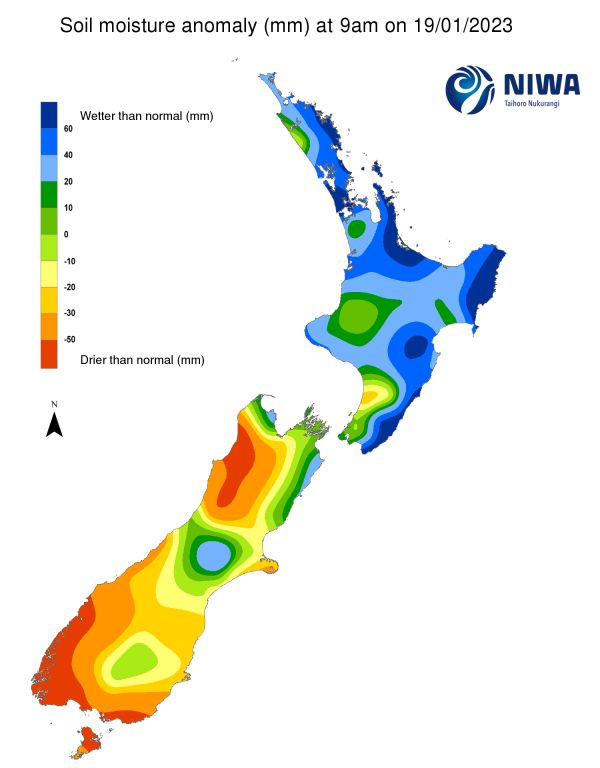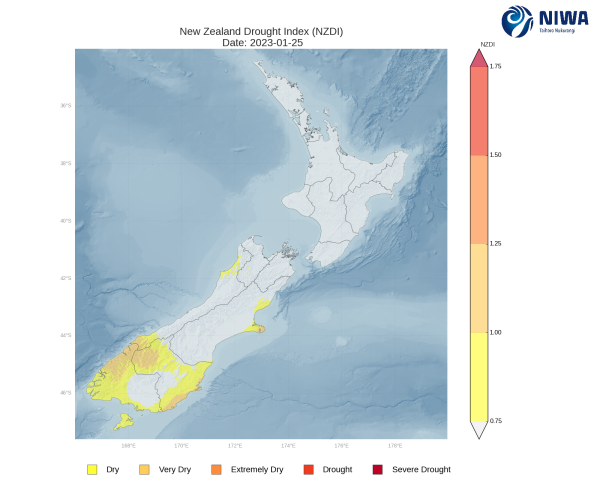A weekly update describing soil moisture patterns across the country to show where dry to extremely dry conditions are occurring or imminent. Regions experiencing significant soil moisture deficits are deemed “hotspots”. Persistent hotspot regions have the potential to develop into drought.
Facts: soil moisture
In the North Island, the past week (through Thursday night) saw generally light rainfall of 15 mm or less, with areas such as southern Northland, Auckland, the east coast, Manawatū-Whanganui, and Wellington receiving 5 mm or less. Isolated pockets of rainfall greater than 30 mm were observed in the Coromandel and western Bay of Plenty, western Waikato, and the Central Plateau. This resulted in soil moisture decreases across the entire North Island, although soil moisture levels remain normal to above normal for most locations despite the recent dryness. The driest soils across the North Island, when compared to normal for this time of the year, are found in southern Manawatū-Whanganui, while the wettest soils for this time of the year are found in eastern Northland, Auckland, the Coromandel Peninsula, western Bay of Plenty, Gisborne, and southern Wairarapa.
The previous hotspot in far southern Manawatū-Whanganui has strengthened and expanded in the past week.
In the South Island, most areas outside the West Coast and Fiordland saw minimal rainfall in the past week (through Thursday night), with totals generally less than 10 mm. However, a portion of interior Canterbury received more than 25 mm. Along the West Coast and Fiordland, most locations received 20-40 mm. This resulted in additional moderate soil moisture decreases for nearly the entire island. The driest soils in the South Island, when compared to normal for this time of the year, are located in much of the West Coast, Fiordland, coastal Southland, and Stewart Island, while the wettest soils for this time of the year are found in a small portion of interior Canterbury and coastal Marlborough.
South Island hotspots are currently located near Nelson, in Banks Peninsula, southern Canterbury, much of Otago, and coastal Southland, and these hotspots generally strengthened in the past week. As of 25 January, the New Zealand Drought Index (NZDI) map below shows that dry conditions are currently located in areas north of Christchurch, Banks Peninsula, coastal Buller, coastal and interior Otago, the lower West Coast, Fiordland, and Stewart Island. In addition, eastern Banks Peninsula, coastal and interior Otago, and northern Fiordland are experiencing very dry conditions.
Outlook and soil moisture
In the North Island, heavy rain will continue in northern and western regions today and Saturday (27-28 January), with moderate to heavy rain in the eastern North Island on Saturday as well. Early-to-mid next week (30 January-1 February) could see another plume of tropical moisture affecting the upper North Island with additional heavy rain. Drier conditions may begin to arrive by late next week. Weekly rainfall totals could reach 100-200 mm in Northland, Auckland, northern Waikato, the Coromandel, Bay of Plenty, East Cape, and Taranaki, with 50-100 mm possible elsewhere in the North Island.
Due to the expected rainfall in the next week, large increases in soil moisture are likely across the entire North Island, particularly from Northland to Bay of Plenty. This may also be accompanied by areas of flooding due to the heavy rain falling on already wet soils. The current hotspot in far southern Manawatū-Whanganui may dissipate in the next week due to the significant rainfall expected.
In the South Island, some showers will affect the east coast and Marlborough on Saturday (28 January). On Sunday and Monday, showers and possibly isolated thunderstorms will affect northern and interior portions of the South Island. From Tuesday (31 January), there will be an increasing chance for rain to develop along the West Coast. Weekly rainfall totals may reach 70-100 mm in much of the West Coast, with 50-75 mm possible in the top of the South Island. However, in the eastern and lower South Island, rainfall totals may only reach 15-30 mm.
Due to the expected rainfall in the next week, soil moisture levels may increase somewhat in the top and west of the South Island. However, small decreases may occur in eastern areas. The current hotspot near Nelson may dissipate in the next week, while those located in the eastern and lower South Island will likely see little change.
During late January and early February, persistently low rainfall and above average temperatures could result in an escalation of the dryness across the lower South Island. This may result in the development of meteorological drought in parts of Otago and Southland next month.
For more information on the potential for dryness in the weeks to come, please check out the drought forecasting tool, a collaboration between NIWA and the Ministry for Primary Industries.
https://shiny.niwa.co.nz/drought-forecast/
Background:
Hotspot Watch: a weekly advisory service for New Zealand media. It provides soil moisture and precipitation measurements around the country to help assess whether extremely dry conditions are imminent.
Soil moisture deficit: the amount of water needed to bring the soil moisture content back to field capacity, which is the maximum amount of water the soil can hold.
Soil moisture anomaly: the difference between the historical normal soil moisture deficit (or surplus) for a given time of year and actual soil moisture deficits.
Definitions: “Extremely” and “severely” dry soils are based on a combination of the current soil moisture status and the difference from normal soil moisture (see soil moisture maps at https://www.niwa.co.nz/climate/nz-drought-monitor/droughtindicatormaps)
Hotspot: A hotspot is declared if soils are "severely drier than normal" which occurs when Soil Moisture Deficit (SMD) is less than -110 mm AND the Soil Moisture Anomaly is less than -20 mm.
Pictured above: Soil Moisture Anomaly Maps, relative to this time of year. The maps show soil moisture anomalies over the past two weeks.
As of 25 January, the New Zealand Drought Index (NZDI) map below shows that dry conditions are currently located in areas north of Christchurch, Banks Peninsula, coastal Buller, coastal and interior Otago, the lower West Coast, Fiordland, and Stewart Island. In addition, eastern Banks Peninsula, coastal and interior Otago, and northern Fiordland are experiencing very dry conditions. Please note: some hotspots in the text above may not correspond with the NZDI map. This difference exists because the NZDI uses additional dryness indices, including one which integrates the rainfall deficit over the past 60 days. Changes are therefore slower to appear in the NZDI compared to soil moisture anomaly maps that are instantaneously updated.




